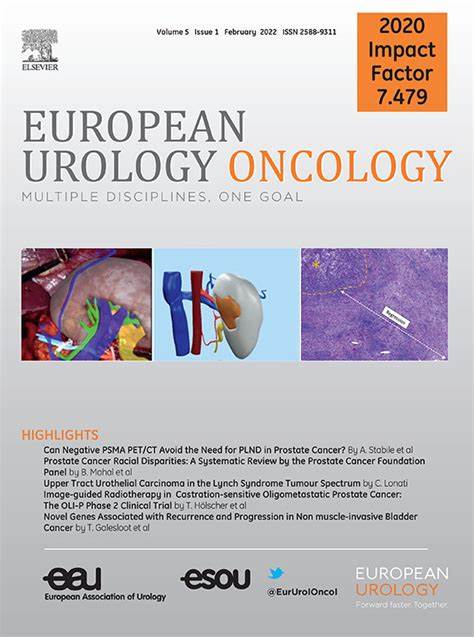用[177Lu]Lu-PSMA-617与卡巴齐他赛治疗转移性钙化抗性前列腺癌(TheraP)患者治疗反应的预后和预测模型的验证:一项随机、开放标签、2 期试验的事后分析。
IF 8.3
1区 医学
Q1 ONCOLOGY
引用次数: 0
摘要
基于一项多中心非比较研究的数据,已经建立了预后模型,以预测接受Lu-PSMA放射治疗的转移性去势抵抗性前列腺癌患者前列腺特异性抗原(PSA50)降低50%、前列腺特异性抗原(PSA)无进展生存期(PFS)延长和总生存期(OS)延长的可能性。与标准化疗相比,这些模型在识别可能从[177Lu]Lu-PSMA中获益最多的患者方面的预测效用尚未建立。目的利用随机、开放标签、2期治疗试验的数据确定模型的预测价值(主要目标),并评估PSA50模型的临床净收益(次要目标)。设计、环境和参与者在2018年2月至2019年9月期间,所有200名患者被随机分配到治疗试验中,接受[177Lu]Lu-PSMA-617 (n = 99)或卡巴他赛(n = 101)治疗。结果测量和统计分析通过测试随机分配到[177Lu]Lu-PSMA和卡巴他赛的患者模型结果分类(有利和不利结果)之间的关联是否不同,来调查预测性能。采用决策曲线分析评估PSA50模型的临床获益。结果和局限性[177Lu]Lu-PSMA-617组患者PSA50评分为良好结局的概率高于卡巴他赛组(优势比为6.36[95%可信区间{CI} 1.69-30.80] vs 0.96 [95% CI 0.32-3.05];模型治疗相互作用P = 0.038)。[177Lu]Lu-PSMA-617与卡巴他赛疗效良好的患者PSA50率分别为62/88(70%)和31/85(36%)。决策曲线分析表明,当PSA反应的概率≥30%时,使用PSA50模型具有临床净获益。PSA - PFS和OS模型的预测性能尚未建立(治疗-模型相互作用:p = 0.36和p = 0.41)。[177Lu]Lu-PSMA-617与卡巴他赛相比,先前开发的PSA50结局分类模型被证明既能预测预后,也能预测预后,而PSA PFS和OS模型仅具有预后价值。这些模型可以帮助临床医生确定转移性去势抵抗性前列腺癌患者的策略,这些患者一线化疗失败,符合[177Lu]Lu-PSMA-617和卡巴他赛的治疗条件。在本报告中,我们验证了先前开发的统计模型,该模型可以预测晚期前列腺癌患者对Lu-PSMA放射配体治疗的反应。我们发现统计模型可以预测患者的生存,并有助于确定Lu-PSMA治疗或卡巴他赛治疗是否更有可能实现血清前列腺特异性抗原反应。本文章由计算机程序翻译,如有差异,请以英文原文为准。
Validation of Prognostic and Predictive Models for Therapeutic Response in Patients Treated with [177Lu]Lu-PSMA-617 Versus Cabazitaxel for Metastatic Castration-resistant Prostate Cancer (TheraP): A Post Hoc Analysis from a Randomised, Open-label, Phase 2 Trial
Background
Prognostic models have been developed using data from a multicentre noncomparative study to forecast the likelihood of a 50% reduction in prostate-specific antigen (PSA50), longer prostate-specific antigen (PSA) progression-free survival (PFS), and longer overall survival (OS) in patients with metastatic castration-resistant prostate cancer receiving [177Lu]Lu-PSMA radioligand therapy. The predictive utility of the models to identify patients likely to benefit most from [177Lu]Lu-PSMA compared with standard chemotherapy has not been established.
Objective
To determine the predictive value of the models using data from the randomised, open-label, phase 2, TheraP trial (primary objective) and to evaluate the clinical net benefit of the PSA50 model (secondary objective).
Design, setting, and participants
All 200 patients were randomised in the TheraP trial to receive [177Lu]Lu-PSMA-617 (n = 99) or cabazitaxel (n = 101) between February 2018 and September 2019.
Outcome measurements and statistical analysis
Predictive performance was investigated by testing whether the association between the modelled outcome classifications (favourable vs unfavourable outcome) was different for patients randomised to [177Lu]Lu-PSMA versus cabazitaxel. The clinical benefit of the PSA50 model was evaluated using a decision curve analysis.
Results and limitations
The probability of PSA50 in patients classified as having a favourable outcome was greater in the [177Lu]Lu-PSMA-617 group than in the cabazitaxel group (odds ratio 6.36 [95% confidence interval {CI} 1.69–30.80] vs 0.96 [95% CI 0.32–3.05]; p = 0.038 for treatment-by-model interaction). The PSA50 rate in patients with a favourable outcome for [177Lu]Lu-PSMA-617 versus cabazitaxel was 62/88 (70%) versus 31/85 (36%). The decision curve analysis indicated that the use of the PSA50 model had a clinical net benefit when the probability of a PSA response was ≥30%. The predictive performance of the models for PSA PFS and OS was not established (treatment-by-model interaction: p = 0.36 and p = 0.41, respectively).
Conclusions
A previously developed outcome classification model for PSA50 was demonstrated to be both predictive and prognostic for the outcome after [177Lu]Lu-PSMA-617 versus cabazitaxel, while the PSA PFS and OS models had purely prognostic value. The models may aid clinicians in defining strategies for patients with metastatic castration-resistant prostate cancer who failed first-line chemotherapy and are eligible for [177Lu]Lu-PSMA-617 and cabazitaxel.
Patient summary
In this report, we validated previously developed statistical models that can predict a response to Lu-PSMA radioligand therapy in patients with advanced prostate cancer. We found that the statistical models can predict patient survival, and aid in determining whether Lu-PSMA therapy or cabazitaxel yields a higher probability to achieve a serum prostate-specific antigen response.
求助全文
通过发布文献求助,成功后即可免费获取论文全文。
去求助
来源期刊

European urology oncology
Multiple-
CiteScore
15.50
自引率
2.40%
发文量
128
审稿时长
20 days
期刊介绍:
Journal Name: European Urology Oncology
Affiliation: Official Journal of the European Association of Urology
Focus:
First official publication of the EAU fully devoted to the study of genitourinary malignancies
Aims to deliver high-quality research
Content:
Includes original articles, opinion piece editorials, and invited reviews
Covers clinical, basic, and translational research
Publication Frequency: Six times a year in electronic format
 求助内容:
求助内容: 应助结果提醒方式:
应助结果提醒方式:


